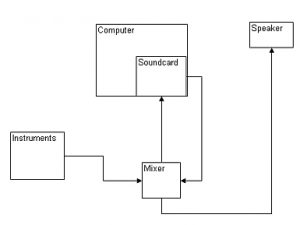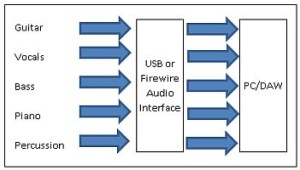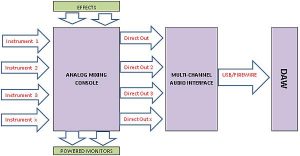Instruments can be connected first to the studio mixer thus conditioning the signal such as amplification and removing of noise. This is recommended for studio recording because the signals are now strong to be recorded and less noise.
Plus since the audio mixers are employed, it will have an excellent frequency response which is very essential for professional recording.
Although this method is great but it does have a lot of disadvantages which are as follows:
a.) You cannot perform multi-channel recording using this setup. Since a mixer stereo output is plugged directly into the sound card line-input. You will only have one stereo signal recorded one at a time. This would work for one at a time recording. But if you are looking forward to record a band simultaneously which consists of several instruments (guitars, bass,vocals); then this setup cannot be relied.
Multichannel recording is the most accepted modern recording techniques. It works by channeling inputs to every tracks created using your recording software. For example if you are recording 3 tracks together (one vocal, one guitar and one bass), then in your multi-track recording software there are also 3 unique tracks created. This is very useful if you are mixing tracks and you can mix them easily using this method.
b.) An impedance mismatch would most likely happen along your signal path. If this would happen, you will have a noisy or weak signal despite having a maximum gain settings on your mixer. You can read this article on the sources of noise and the solutions.
Method 3: Using mixer to route all signals coming to it and from the computer
This is an efficient one, because all controls of the volume is on the mixer. In this setup, the instruments are feed to the mixer, the mixer then conditions the signal by using it’s pre-amp features or some EQ then it is being feed finally to the audio interface/soundcard for DAW analog to digital conversion.
At the same time the audio recording software feeds out signal to the soundcard/audio interface which then connects to another input in the mixer to control the volume. The mixer output then connects to the studio monitors/speakers to hear the signals being played. This is a very useful setup during multi-track recording.
For best results, you should be using a mixer capable of having input and output signals very well. These are big mixers and can cost a lot. Also you need a multi-channel recording audio interface/ASIO compatible and should be external audio interfaces not onboard.
Method 3: Using external audio interface only
Today’s external audio interface (whether Firewire or USB) are very powerful. They can handle mixing tasks and allows you to do multi-channel recording without having to use an external audio mixer. Modern audio interface can handle a lot of inputs at the same time. For example if you have 5-input multi-channel audio interface, you can record 5 musical instruments to your DAW software simultaneously as 5 different tracks. See screenshot below:
Method 4: Using external audio interface and mixer direct signal path
In this type of setup, you will have the luxury of conditioning the signal first using the mixing console high quality pre-amp (only if you are using a console with great sounding pre-amps like Neve). This is complex and very expensive methods of recording. You can see the setup flow below:
On the audio playback, it would be connected to your audio interface analog outputs instead to the mixer. This what makes this method different from Method 3. There are several advantages of having this setup. One big advantage is that you can mix outside the box. You can read this post on the mixing ITB vs. OTB.
Try to experiment other types of setup that fits your budget and your needs. But the method 3 is the most recommended method if you are into professional audio CD production.
Content last updated on July 4, 2012


